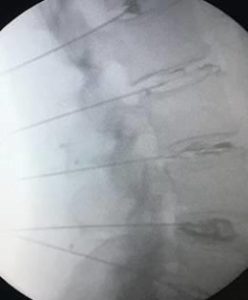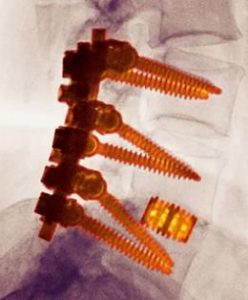
Benefit from the fast, minimally invasive alternative to Spinal Surgery
Invented in Texas, Serving Texans for Over 20 Years
12,500+ Procedures, >82% Success Rate

The Discseel Procedure
The Discseel® Procedure is a minimally invasive procedure that allows patients to relieve their low back and neck pain without surgery. It is the only procedure proven to seal discs which encourages them to heal. The Discseel Procedure has excellent long-term outcomes proven in peer-reviewed literature.

Spinal Fusion Surgery
Spinal Fusion surgery utilizes bone grafts, metal screws, rods, or plates to fuse the vertebrae, limiting motion at that segment of the spine. This procedure aims to alleviate pain by stabilizing the spine, but it may result in reduced mobility and may require a prolonged recovery period.
The First Step is a FREE Phone Consultation
Complete the form and an expert will contact you.
Learn if the Discseel Procedure can stop your pain.
Explore Your Options
Having the Discseel Procedure DOES NOT make you ineligible for surgery later if needed. Discseel however, treats the cause of your pain with fewer risks.
Informed Decision-making
You owe yourself a second opinion. A second opinion may provide additional options and help you evaluate the benefits and risks. Spine Surgery has potentially life-altering outcomes; having all valid options is to your benefit when making a decision.
We never charge for a second opinion.
Prevent unnecessary surgeries
There are non-invasive treatment options beyond surgery that can effectively treat back and neck pain. Getting a second opinion helps to navigate the diversity of treatment options. This fosters a more comprehensive understanding of the condition and ensures that patients will undergo treatment that is both effective and tailored to their individual needs.
Types of Spine Surgeries
Discsectomy
This procedure involves the removal of part or the entire damaged intervertebral disc to relieve pressure on spinal nerves.
Laminectomy
In this surgery, a portion of the lamina (bony arch) of the vertebra is removed to alleviate pressure on the spinal cord and nerves.
Foraminotomy
This surgery enlarges the openings (foramina) in the spine through which nerve roots exit. It is often performed to relieve pressure on spinal nerves.
Spinal Fusion
This procedure involves fusing two or more vertebrae together to stabilize the spine and reduce pain.
Artificial Disc Replacement
Instead of fusing vertebrae, this surgery involves replacing a damaged disc with an artificial one to maintain spinal motion.
Vertebroplasty and Kyphoplasty
These procedures involve the injection of bone cement into fractured vertebrae to stabilize and relieve pain.
Potential Complications Reduced With The Discseel Procedure
Infection
Surgical site infections can affect the skin, muscles, or deeper structures around the spine and may require further surgery.
Nerve Damage
Surgical site infections can affect the skin, muscles, or deeper structures around the spine and may require further surgery.
Persistent Pain
Some patients continue to experience pain after surgery, either due to persistence of the original condition, the development of scar tissue, or other factors.
Hardware Complications
Surgeries involving the implantation of screws, rods, or artificial discs may have complications such as migration, breakage, or irritation of surrounding structures.
Adjacent Segment Degeneration
Fusion surgeries may increase stress on adjacent segments, potentially accelerating the degeneration of those segments over time.
Incomplete Relief of Symptoms
Some patients do not experience complete relief of their symptoms. This could be due to factors like incomplete decompression, nerve damage, or the multifactorial nature of certain conditions.
How Does Discseel Compare?

Surgery
Compare
Invasiveness

Non-invasive approach without surgical incisions or hardware implants, minimizing tissue damage and promoting quicker recovery.
Surgery
Involves extensive surgical incisions, hardware implants (screws, rods), and fusion of vertebrae, leading to substantial tissue trauma and prolonged recovery.
Compare
Recovery Time

Short recovery time, allowing most individuals to resume light activities within 24 hours and gradually increase activity levels as comfort allows.
Surgery
Lengthy recovery period spanning several months to a year, often involving restricted movements and physical therapy to aid healing.
Compare
Targeted Treatment

Targets specific disc tears, sealing the tissue so that natural healing and tissue regeneration can occur, aiming to preserve mobility and disc function.
Surgery
Addresses spinal instability by fusing vertebrae, which limits mobility at the fused area, potentially transferring stress to adjacent discs.
Compare
Risks and Complications

Minimizes risks associated with invasive surgeries, focusing on sealing and repairing disc tears without the complications of hardware placement or extensive tissue disruption.
Surgery
Risks include infection, blood clots, nerve damage, and potential failure of fusion leading to persistent pain and the need for revision surgery
Compare
Long Term Outcomes

Aims for natural healing and preservation of disc function, potentially offering sustained relief without compromising spinal mobility or necessitating further interventions.
Surgery
While effective in stabilizing the spine, may result in limited mobility, altered spinal mechanics, and potential stress on adjacent discs, necessitating future surgeries.